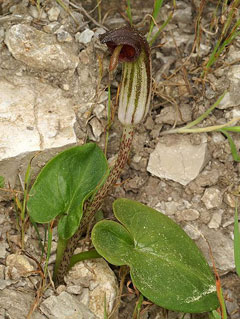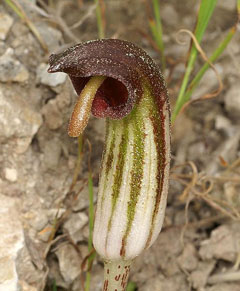 |
|
http://commons.wikimedia.org/wiki/User:Orchi |
 |
| http://commons.wikimedia.org/wiki/User:Orchi |
Translate this page:
Summary
Physical Characteristics

 Arisarum vulgare is a PERENNIAL growing to 0.5 m (1ft 8in).
Arisarum vulgare is a PERENNIAL growing to 0.5 m (1ft 8in).
See above for USDA hardiness. It is hardy to UK zone 7. It is in leaf from October to July, in flower in May. The species is monoecious (individual flowers are either male or female, but both sexes can be found on the same plant) and is pollinated by Insects.
Suitable for: light (sandy) and medium (loamy) soils. Suitable pH: mildly acid, neutral and basic (mildly alkaline) soils. It can grow in full shade (deep woodland) or semi-shade (light woodland). It prefers moist soil.
UK Hardiness Map
US Hardiness Map
Synonyms
Plant Habitats
Woodland Garden Dappled Shade; Shady Edge; not Deep Shade; Ground Cover;
Edible Uses
Edible Parts: Leaves Root
Edible Uses:
Root - cooked. The acrid juice should first be removed by thorough and repeated washing leaving behind a nutritious and innoxious residue[2, 105, 177]. Thorough drying or cooking will also destroy any harmful elements of this root[K]. The root is frequently used as an emergency food in times of scarcity, it is about the size of a walnut[2]. One report suggests that the leaves might be edible[177]. If they are they must be well cooked first[K].
References More on Edible Uses
Medicinal Uses
Plants For A Future can not take any responsibility for any adverse effects from the use of plants. Always seek advice from a professional before using a plant medicinally.
None known
References More on Medicinal Uses
The Bookshop: Edible Plant Books
Our Latest books on Perennial Plants For Food Forests and Permaculture Gardens in paperback or digital formats.

Edible Tropical Plants
Food Forest Plants for Hotter Conditions: 250+ Plants For Tropical Food Forests & Permaculture Gardens.
More

Edible Temperate Plants
Plants for Your Food Forest: 500 Plants for Temperate Food Forests & Permaculture Gardens.
More

More Books
PFAF have eight books available in paperback and digital formats. Browse the shop for more information.
Shop Now
Other Uses
A good ground-cover plant for a shady place[1].
Special Uses
Ground cover
References More on Other Uses
Cultivation details
Prefers a woodland soil or a sandy loam with leafmould[1]. Grows well in shady rather moist places[1]. A Mediterranean plant, it commences growth in the autumn and, since the leaves are not very hardy, the plant is best grown under protection[90]. It should succeed outdoors at least in the milder parts of the country, if grown in a sheltered woodland. The plant is hardy to about -10°c for short periods but should be given a good mulch in the winter[200]. The plant becomes dormant in spring/summer[200].
References Carbon Farming Information and Carbon Sequestration Information
Temperature Converter
Type a value in the Celsius field to convert the value to Fahrenheit:
Fahrenheit:
The PFAF Bookshop
Plants For A Future have a number of books available in paperback and digital form. Book titles include Edible Plants, Edible Perennials, Edible Trees,Edible Shrubs, Woodland Gardening, and Temperate Food Forest Plants. Our new book is Food Forest Plants For Hotter Conditions (Tropical and Sub-Tropical).
Shop Now
Plant Propagation
Seed - we have no details for this species but suggest sowing the seed in a shady part of the greenhouse as soon as it is ripe in the spring if this is possible. Sow stored seed in early spring. When large enough to handle, prick the seedlings out into individual pots and grow them on for at least the first winter in a greenhouse and plant out when dormant in the summer once the tuber has reached a reasonable size. Division in spring after the plant dies down[1].
Other Names
If available other names are mentioned here
Native Range
TEMPERATE ASIA: Egypt (Sinai), Israel, Jordan, Lebanon, Syria (west), Turkey, Armenia, Azerbaijan EUROPE: Former Yugoslavia, Albania, Greece (incl. Crete), Italy (incl. Sardinia, Sicily), Spain (incl. Baleares), France (incl. Corsica) AFRICA: Spain (Canarias), Portugal (Madeira Islands), Algeria, Egypt (north), Libya (north), Morocco
Weed Potential
Right plant wrong place. We are currently updating this section.
Please note that a plant may be invasive in one area but may not in your area so it's worth checking.
Conservation Status
IUCN Red List of Threatened Plants Status :

Growth: S = slow M = medium F = fast. Soil: L = light (sandy) M = medium H = heavy (clay). pH: A = acid N = neutral B = basic (alkaline). Shade: F = full shade S = semi-shade N = no shade. Moisture: D = dry M = Moist We = wet Wa = water.
Now available:
Food Forest Plants for Mediterranean Conditions
350+ Perennial Plants For Mediterranean and Drier Food Forests and Permaculture Gardens.
[Paperback and eBook]
This is the third in Plants For A Future's series of plant guides for food forests tailored to
specific climate zones. Following volumes on temperate and tropical ecosystems, this book focuses
on species suited to Mediterranean conditions—regions with hot, dry summers and cool, wet winters,
often facing the added challenge of climate change.
Read More
Expert comment
Author
Targ-Tozz.
Botanical References
45200
Links / References
For a list of references used on this page please go here
Readers comment